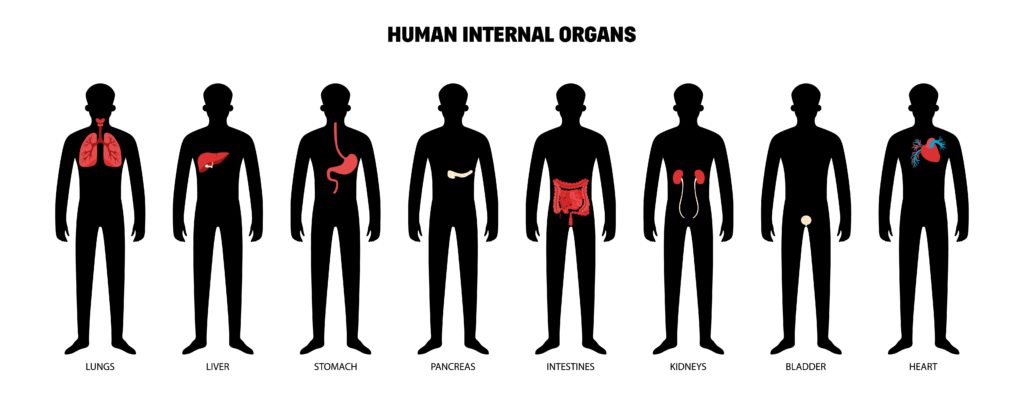
Vehicles produce a lot of momentum and force when in motion, and in the event of a collision, those forces are transferred to a vehicle’s occupants. While our bodies can withstand a lot of force, they are not impervious to injury, which is why so many car and truck accident victims suffer internal injuries. These are one of the most dangerous types of injuries that a person can sustain, largely because they are so difficult to diagnose and if not treated in time, can even result in the death of the accident victim.
Categories of Internal Injuries
Internal injuries can be caused by two different types of trauma: blunt trauma and penetrating trauma. The former happens when a part of the victim’s body collides with something else at high speeds. The sheer force of impact can cause bruising and other injuries to the organs and blood vessels. Internal injuries caused by penetrating trauma, on the other hand, occur when a foreign object actually punctures the skin, damaging blood vessels and potentially piercing an organ. A broken rib, for instance, can easily puncture a lung, causing air to escape and lodge inside the thoracic cavity. The resulting loss of oxygen can be painful and dangerous, as the accumulated pressure in the chest will prevent the lungs from fully expanding, eventually leading to the organ’s collapse.
Traumatic Brain Injuries
Sudden collisions can cause the brain to strike the inside of the skull, resulting in bruising and even bleeding inside the brain. An object going through the brain tissue, such as a shattered piece of skull, can also cause a traumatic brain injury (TBI). When such an injury is mild, a victim’s brain cells may only temporarily be damaged, resulting in minor headaches and nausea. When, however, a more serious trauma leads to bruising, torn tissues, bleeding, and other physical damage, the results tend to be more far-reaching and could even lead to permanent brain damage.
Organ Damage
The force of an accident can result in significant injuries to a person’s organs, causing problems like bruising, bleeding, and organ failure. Certain organs are especially at risk of injury, including the liver and kidneys. Common symptoms of accident-related organ damage include abdominal pain, back pain, and low blood pressure. Unfortunately, organ damage is difficult to diagnose, especially when the injury is to the spleen, liver, pancreas, or gallbladder, which don’t produce the same kinds of outward swelling and injuries as do the muscles, skin, and bone.
Internal Bleeding
Severe organ damage can lead to internal bleeding, which occurs when excessive force causes the blood vessels to rupture. If the damage is excessive, the body is unable to clot the blood in time to repair the damaged vessels, resulting in serious problems, including potential organ failure. Unfortunately, internal bleeding symptoms can take days to appear, by which time, the damage may be irreversible. The most common symptoms include weakness, dizziness, sudden headaches, loss of balance, and abdominal pain.
Diagnosing and Treating an Internal Injury
To diagnose an internal injury, an accident victim will need to seek medical attention immediately and obtain an x-ray, CT scan, or angiography. These scans allow medical professionals to examine the bones, tissues, and blood vessels closely to ensure that there has been no damage from blunt force impact. Emergency rooms also often use ultrasounds to check for bleeding or fluid accumulation, which could be indicative of an internal injury.
How an internal injury is treated will depend on the specific diagnosis. Internal bleeding, for instance, may require blood transfusions and surgical repair of blood vessels, while organ damage could necessitate the removal of part or all of the organ. Damaged spleens, for instance, must often be removed to prevent internal bleeding. Accident victims may also require antibiotics and other medications to prevent and treat infections, which are much more common with penetrating injuries. Head injuries could also require surgery to reduce pressure and swelling on the brain, as well as ongoing therapies once treatment is complete. These costs can quickly add up, which can be stressful for accident victims who are trying to focus on their recovery. Fortunately, injured parties who can prove that someone else’s negligence caused the accident could be entitled to compensation for their losses.
Contact Our Experienced Wrongful Death Lawyers
Tragically, catastrophic injuries, like internal bleeding and organ damage can prove deadly for accident victims. While recovering financial reimbursement can never truly compensate an accident victim’s family for the untimely loss of a loved one, it can make it possible to pay medical bills and household expenses while the family grieves. To speak with an experienced Miami wrongful death lawyer about your legal options, call Dolan Dobrinsky Rosenblum Bluestein at 786-661-1359 today.